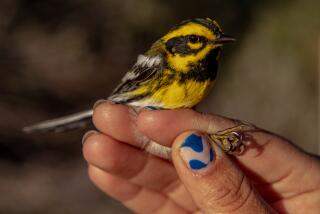Father, Daughter Take to the Skies for Posterity
- Share via
MERIDEN, N.H. — About 40 years ago, Ira Townsend paid a surprise visit to his daughter, Patsy, at boarding school. The World War II pilot asked her if she might like to learn to fly, and attached one condition: “Let’s not tell Mom.”
Thus began a shared passion.
Look above the gentle hills of central New Hampshire and you will see them many mornings at dawn, and again just before sunset. That’s Patsy, 56, in the pilot’s seat and Ira, 85, hanging out the open doorway, snapping pictures.
His plan is to take his 30-year-old Minolta and photograph every piece of property in three villages in this region, known as the Upper Valley. The retired math teacher has become an aerial anthropologist, documenting the changes in the quiet area where he has lived his entire life.
“Most people never get to see what the land looks like from up here,” said Townsend, standing beside his daughter and the ultralight airplane he built.
So far, Patsy Townsend said, her father has donated about 200 photographs to the local library. Residents pore through the collection to locate their own properties -- or to spy on developments that may be too hidden by trees to be seen from ground level.
“It is a posterity thing,” she said. “It’s a way of foot-printing everything.”
At a time when her classmates were getting driver’s licenses, Patsy took to flying with fervor. She finished flight school in half the usual time. While attending the University of New Hampshire in the late 1960s, she taught flying -- adopting the name “Sam” from her recently deceased dog because, she said, no one wanted to sign up for lessons from a woman. When students arrived to find she was the only instructor, they’d stay and take the lessons anyway.
At 5 feet 2, Patsy was too short to become a commercial pilot; so she continued to teach flying around the country before landing a job in 1985 as an air traffic controller in Nashua, N.H., an hour and a half from her parents’ house.
Meanwhile, using dynamite and a chain saw, her dad worked about three decades to clear a 1,250-foot runway on the family’s heavily wooded, 140-acre here.
Father and daughter first used a $10,000 family inheritance to buy a Cessna. Then, three years ago, Ira sent away for a kit to build the ultralight.
Patsy said that she thought her father was nuts when he decided to devote an entire New Hampshire winter to assembling the airplane. “Fortunately,” she said, “it was a mild winter.”
But Ira did know that he was too old to feel comfortable at the controls of the new aircraft.
His reflexes may have slowed, but not his love for flying. So when he dreamed up his plan to document the local landscape, Ira drafted Patsy as his partner, “mostly because she’s such a great pilot,” and because their outings provided priceless time together.
The pair take the plane, christened the Flight Star, to altitudes up to 2,500 feet. It can fly about 55 mph, running on automobile-grade gasoline, and holds about four hours’ worth of fuel. On takeoff, the 500-pound, hot pink-and-purple craft growls like a lawnmower.
The Federal Aviation Administration estimates that about 15,000 ultralight planes are in use in the country. The agency recently proposed new standards for pilot certification on such aircraft.
“Everybody builds their own, so there is a lot of room for error with these things,” Patsy noted.
The Townsends often grab a cup of morning coffee in their kitchen, then walk about two minutes to the hangar that sits between Ira’s 1803 home and the sturdy wooden barn that was built soon thereafter.
“It is so great to just get out and go,” Ira said. “No security, no lineup to taxi, no waiting. Boy, it is pretty up there.”
Ira and Patsy have removed the passenger side door of the two-person aircraft to get an even better view. But when the the temperature drops in the fall, they will put the door back on.
With photo albums scattered on the kitchen table, Sara Townsend, a retired state legislator, likens her husband’s landscape history to something out of the Depression-era Works Project Administration.
“Only he doesn’t get paid,” she said. “It is a total labor of love.”
The character of the area is not yet in jeopardy, Ira said. He and Sara have placed their property in a conservancy trust so that it will be preserved.
The one-lane covered bridge that leads to the Townsends’ dirt road still stands as a landmark. But the scenery is changing fast.
Houses are popping up in the area at an astonishing rate, Ira said.
Many are showy, faux-colonial residences built for doctors at the Dartmouth College’s medical center a few miles away.
“I have often thought it would have been nice to have taken pictures 30 years ago to see how things had changed,” Ira said. “Now we will have a record for the future.”
More to Read
Sign up for Essential California
The most important California stories and recommendations in your inbox every morning.
You may occasionally receive promotional content from the Los Angeles Times.













